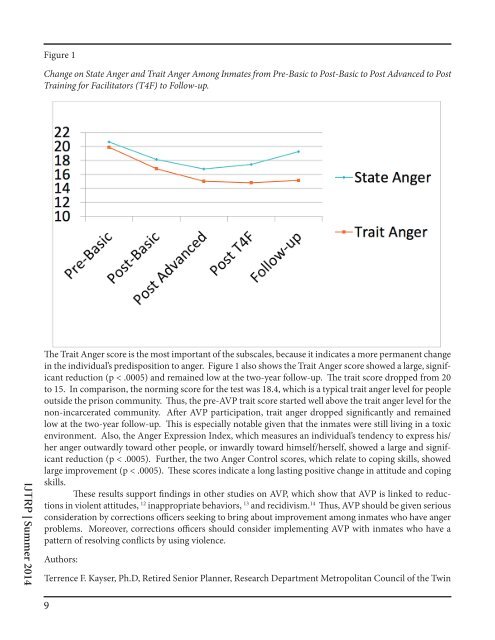Figure 1Change on State <strong>Anger</strong> <strong>and</strong> Trait <strong>Anger</strong> Among Inmates from Pre-Basic to Post-Basic to Post Advanced to PostTraining for Facilitators (T4F) to Follow-up.IJTRP | Summer 2014The Trait <strong>Anger</strong> score is the most important <strong>of</strong> the subscales, because it indicates a more permanent changein the individual’s predisposition to anger. Figure 1 also shows the Trait <strong>Anger</strong> score showed a large, significantreduction (p < .0005) <strong>and</strong> remained low at the two-year follow-up. The trait score dropped from 20to 15. In comparison, the norming score for the test was 18.4, which is a typical trait anger level for peopleoutside the prison community. Thus, the pre-AVP trait score started well above the trait anger level for thenon-incarcerated community. After AVP participation, trait anger dropped significantly <strong>and</strong> remainedlow at the two-year follow-up. This is especially notable given that the inmates were still living in a toxicenvironment. Also, the <strong>Anger</strong> Expression Index, which measures an individual’s tendency to express his/her anger outwardly toward other people, or inwardly toward himself/herself, showed a large <strong>and</strong> significantreduction (p < .0005). Further, the two <strong>Anger</strong> Control scores, which relate to coping skills, showedlarge improvement (p < .0005). These scores indicate a long lasting positive change in attitude <strong>and</strong> copingskills.These results support findings in other studies on AVP, which show that AVP is linked to reductionsin violent attitudes, 12 inappropriate behaviors, 13 <strong>and</strong> recidivism. 14 Thus, AVP should be given seriousconsideration by corrections <strong>of</strong>ficers seeking to bring about improvement among inmates who have angerproblems. Moreover, corrections <strong>of</strong>ficers should consider implementing AVP with inmates who have apattern <strong>of</strong> resolving conflicts by using violence.Authors:Terrence F. Kayser, Ph.D, Retired Senior Planner, <strong>Research</strong> Department Metropolitan Council <strong>of</strong> the Twin9
Cities, 1983-2006.Laura Roberts, PhD: President <strong>of</strong> Right Angle Educators, an international dissertation mentoring corporation,Pr<strong>of</strong>essor <strong>of</strong> <strong>Research</strong> Methods <strong>and</strong> Statistics, served as research methods <strong>and</strong> statistics consultant forover 125 successful doctoral dissertations, published widely in the areas <strong>of</strong> peace technology, educationalleadership, teacher retention, <strong>and</strong> sex differences in mathematics achievement. I serve as consultant forPeace Praxis, an organization dedicated to promoting Peace technology in schools, I wrote <strong>and</strong> evaluateda peace skills training program for middle schoolers called Project WIN (Working out Integrated Negotiations).John A. Shuford, Ed.S., MBA, President <strong>of</strong> Conflict Resolution Services, Vice-President <strong>of</strong> AVP <strong>International</strong>,Past President <strong>of</strong> AVP USA.John Michaelis, President AVP <strong>International</strong>.Footnotes1National Public Radio Interview. (2013) http://www.goodradioshows.org/peaceTalksL98.htm2O’Connor, J. V. Quaker Project Offers Inmates Alternative to Violence Actions. New York Times 8/11/96.3Deeney, J. (2013). A Philadelphia School’s Big Bet on Nonviolence. The Atlantic July 18, 2013 http://www.theatlantic.com/national/archive/2013/07/a-philadelphia-schools-big-bet-on-nonviolence/277893/4Shuford, J. A. <strong>and</strong> Spencer, H. T. (1999). Experiential Conflict Resolution for Prison Staff, CorrectionsToday, (Feature Article) American Correctional Association, Vol. 61, No. 7, Page 96.5Shuford, J. A. <strong>and</strong> Spencer, H. T. (1999). Experiential Conflict Resolution for Prison Staff, CorrectionsToday, (Feature Article) American Correctional Association, Vol. 61, No. 7, Page 96.6Spinaris, C. G., Denh<strong>of</strong>, M. D. <strong>and</strong> Kellaway, J. A. (2012). “Posttraumatic Stress Disorder in United StatesCorrections Pr<strong>of</strong>essionals: Prevalence <strong>and</strong> impact on Health <strong>and</strong> Functioning. Desert Waters CorrectionalOutreach. http://www.desertwaters.com7ToersBijns, C. (2012) Suicide – Correctional Officers Cause & Effect <strong>of</strong> Workplace Stress. Corrections.com. http://www.corrections.com/news/article/318978ToersBijns, C. (2012) Suicide – Correctional Officers Cause & Effect <strong>of</strong> Workplace Stress. Corrections.com. http://www.corrections.com/news/article/318979Denh<strong>of</strong>, M. D., <strong>and</strong> Spinaris, C. G. (2013). “Depression, PTSD, <strong>and</strong> Comorbidity in United States CorrectionsPr<strong>of</strong>essionals: Prevalence <strong>and</strong> Impact on Health Functioningk.” Desert Waters Correctoinal Outreachhttp://www.desertwaters.com10Denh<strong>of</strong>, M. D., <strong>and</strong> Spinaris, C. G. (2013). “Depression, PTSD, <strong>and</strong> Comorbidity in United States CorrectionsPr<strong>of</strong>essionals: Prevalence <strong>and</strong> Impact on Health Functioning.” Desert Waters Correctoinal Outreachhttp://www.desertwaters.com11ToersBijns, C. (2012) Suicide – Correctional Officers Cause & Effect <strong>of</strong> Workplace Stress. Corrections.com. http://www.corrections.com/news/article/3189712Walrath, C. (2001). Evaluation <strong>of</strong> an inmate-run alternatives to violence project: The impact <strong>of</strong> inmate-to-inmateintervention. <strong>Journal</strong> <strong>of</strong> Interpersonal Violence, 16, 697-711.IJTRP | Summer 201410


